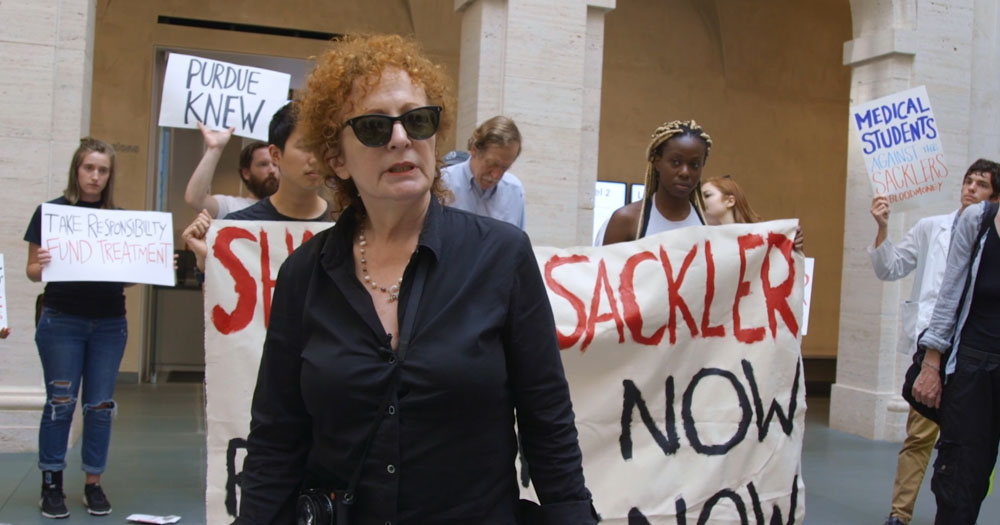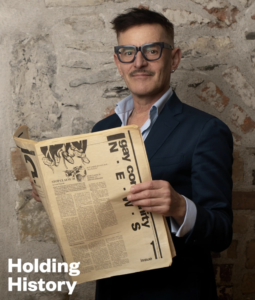A stunning new documentary by Laura Poitras capturing the battle between Nan Goldin and the billionaire Sackler family who are widely blamed for sparking the opioid crisis has reached Irish screens. Han Tiernan chatted to Poitras about her unmissable work of art about the work of an artist.
In so many ways, the ‘art world’ conforms to all the trappings of capitalism. Works of art are bought and sold as if they were a commodity like any other. Like most capitalist models, the rich keep getting richer as the spread of wealth gets thinner and thinner the closer you get to the production line.
Occasionally, a few select artists are catapulted to the status of celebrity on the premise that their work somehow transcends their peers. In actuality, this is often highly subjective, often fad-based, and always determined by an elite cohort of self-appointed arbiters of taste.
But there is also another class of celebrity within the art world – one which could be argued deserves greater appreciation – consisting of those who succeed through unflinching hard work, dogged determination and, crucially, innate talent.
One such artist, Nan Goldin, has become the subject of the captivating new documentary, All the Beauty and the Bloodshed, directed by the award-winning filmmaker Laura Poitras.
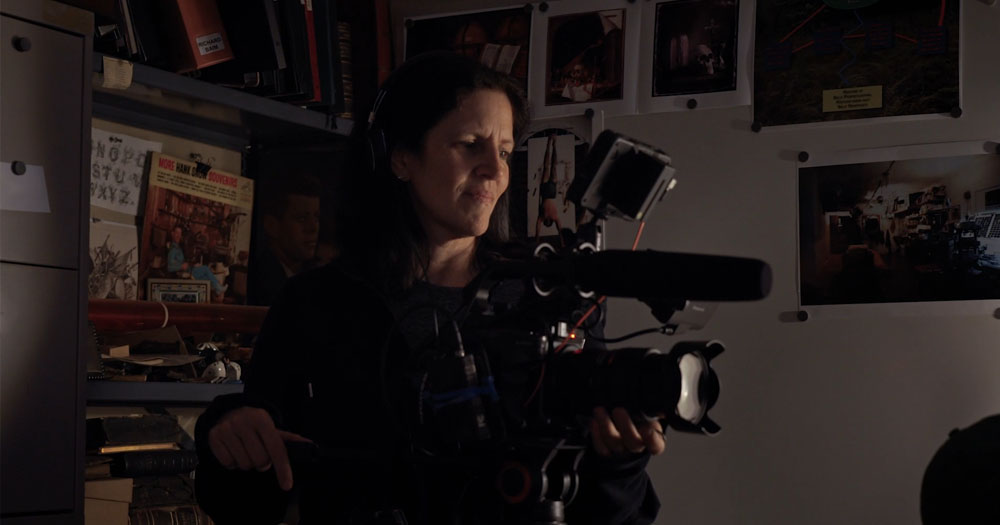
For those unfamiliar with Poitras’s work, she has forged an illustrious career as a master documentarian, tenaciously choosing projects that uncover truths, expose corruption and highlight human rights violations. Her Oscar-winning Citizenfour, about Edward Snowden and his decision to whistleblow on US government surveillance, formed the third part of a broader trilogy about violations resulting from the US War on Terror, beginning with My Country, My Country and The Oath.
Her 2016 film, Risk, initially set out to document the plight of Julian Assange amid his extradition from Switzerland. However, to more accurately portray Assange’s true character, in 2017, Poitras re-edited the film to focus on Assange’s problematic relationship with women following allegations of abuse.
In as much as Poitras’s most recent offering is a documentary about Nan Goldin and her artistic career, it is also about Goldin’s campaign to uncover and challenge the most sinister sides of capitalism – greed masked by public philanthropy – by taking on the Sackler family name.
In 2017, Goldin published a photo essay in Artforum Magazine, documenting her experience of addiction to the prescription drug OxyContin – a highly addictive opioid produced by Perdue Pharma, formerly owned by the Sackler family.
In the essay, she explained her motivation for forming the campaign group PAIN (Prescription Addiction Intervention Now). The group initially aimed to employ direct action tactics to expose the Sackler family and their culpability in the deaths of over half a million Americans, which PAIN attributes to being a direct result of opioid addiction resulting from OxyContin. PAIN began staging direct actions at major museums and art galleries that had been the beneficiaries of substantial endowments in return for dedicated wings, schools, institutes, museums and galleries all immortalising the Sackler name
Poitras describes what drew her to the project, “For me, the hook was this confronting power – in somebody who had the cultural capital and power that she [Goldin] could leverage against the Sacklers, this billionaire wealthy family, and the fact that she herself experienced an OxyContin addiction. And it’s not like it’s a revenge thing– she uses that very strategically – like, ‘I know what your drug does to a person’s body’… it’s not so much centred on her and her case but just knowing how addictive it is.”
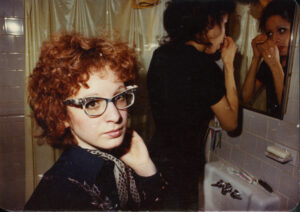
Poitras had been aware of Goldin’s work since the mid-80s, following the publication of her acclaimed photographic diary, The Ballad of Sexual Dependency. She immediately resonated with the work. “I think so many people have that experience… in terms of seeing Nan’s work and then realising, ‘Oh, I’m not alone in coming out’ or just feeling like there is a place for people who maybe don’t feel like wherever they are that it exists. And so that’s almost the real magic of what she’s done.”
The pair first met at a film festival in 2015 when Poitras was screening Citizenfour and later reconnected in 2018 after Nan Goldin had begun the demonstrations with PAIN. The organisation had already started documenting some protests but decided they would need to bring a director on board. Poitras was quickly invested and could see the value in the project. “So much about the struggle that people have – I mean, the failure of society to provide resources to people first of all, the failure just to stop the epidemic before it got out of control, and then the failure to provide support systems – and then you have people who feel shame, and they don’t seek help. And so, I think that Nan is really passionate about destigmatising.”
She continues, “We really need these examples of people who are taking action and having success. I also was so blown away that she was using her stature in the art world to call for accountability. Not everybody does that; I mean, most people don’t.”
Many of the actions undertaken by PAIN are inspired by the direct actions that ACT UP (AIDS Coalition to Unleash Power) launched in the ‘80s. Poitras was careful to recognise this correlation. “I knew really early on how important it was to juxtapose the AIDS crisis and the Oxy overdose crisis, both because Nan has found herself twice in her life confronted with absolute devastation and tragedy and loss… And in both cases… she didn’t just sit back, she was like, ‘I have to do something’.”
Nan Goldin states in her Artforum essay, “I believe I owe it to those affected by this epidemic to make the personal political.”
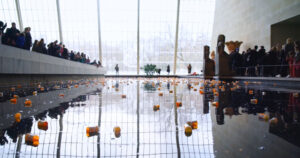
One of the overarching successes of the film is how Poitras seamlessly weaves footage of the PAIN demonstrations with the narration of Goldin’s personal life and her artwork. For this, Poitras employs a chaptered structure, intersecting the chaotic nature of the demonstrations with intimate snapshots of Goldin’s life. Much of this is done through the use of archival footage. “Most of my films, before this one, are usually told in the present tense, like something’s unfolding in real-time… And there’s a palpable sense of being there – like in the present moment and not like nostalgic reflection.”
She continues, “With these archival elements, we tried to transport the audience so that you feel like you’re in David Wajnarovicz’s kitchen… allow it not to be something that’s just being described, so you feel like you’re there.” Coupled with the archival footage, Poitras’s willingness to invest personally in her projects also paid dividends. “The trust was really deep and intimate, and I took it really seriously.”
“I created a lot of safety nets around it to protect [Nan] because she was sharing so much. Both in creating a very small circle who would hear anything, [making sure] that she would hear things before anyone else did, and other things you would do if somebody was sharing with you the most personal parts of their life… So I felt very quickly that we got to this place of real, deep honesty both in the words she uses and even the way she speaks.”
During the interviews, Nan Goldin speaks candidly about her experiences of sex work, domestic violence, mental health, her sister’s suicide, and of course, addiction. Throughout the film, Poitras achieves a majestic balance in the importance weighted on each subject but at no point does any of it feel overwhelming.
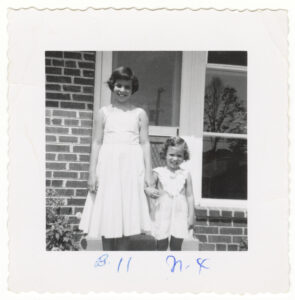
“I felt really strongly about the importance of her sister Barbara in this film… And it’s not just the tragedy of her suicide and her institutionalisation, but I also feel it’s the denialism around it- some of the rage comes from that denialism. So you have the family that’s not able to [be open] and then societal denialism around mental health.”
She concludes with her aspiration for the film, “I really do hope that when people see the film, the language you use around anyone who’s struggling with drugs, or who has experienced domestic abuse or sex work, all of the things that are in the film, that that destigmatises them. And that it also fully places the shame where the shame belongs, which is on the evil profiteers who stood by and allowed this tragedy to happen and to profit from it.”
All the Beauty and the Bloodshed is currently screening in selected cinemas nationwide.
This article appears in issue 376 of GCN magazine. Read the full issue for free here.
© 2023 GCN (Gay Community News). All rights reserved.
This article was published in the print edition Issue No. 376 (March 1, 2023). Click here to read it now.
Support GCN
GCN is a free, vital resource for Ireland’s LGBTQ+ community since 1988.
GCN is a trading name of National LGBT Federation CLG, a registered charity - Charity Number: 20034580.
GCN relies on the generous support of the community and allies to sustain the crucial work that we do. Producing GCN is costly, and, in an industry which has been hugely impacted by rising costs, we need your support to help sustain and grow this vital resource.
Supporting GCN for as little as €1.99 per month will help us continue our work as Ireland’s free, independent LGBTQ+ media.
